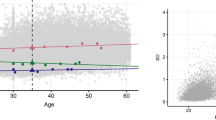Abstract
Uniovular and diovular twin pairs can be classified with at least 90% accuracy by careful questioning or by ratings by observers of similarity in appearance, eye color, ear conformation, and the like. This article outlines the methods required for highly accurate zygosity diagnosis using blood typing, fingerprints, and anthropometry. The logic behind the use of discrete Mendelian phenotypes is explained and tables are provided which give the odds against a dizygotic twin pair showing concordance on eight blood group systems, four serum proteins, and six red blood cell enzymes. These tables are suitable for use with American twins of European ancestry; the method of generating such tables is explained so that similar tables based on different gene frequency estimates or for additional genetic markers can be easily constructed. The logic behind the use of metric, polygenic traits in zygosity diagnosis is also presented, together with tables giving the odds against a dizygotic twin pair showing various degrees of similarity in ponderal index, in cephalic index, and in Slater's Z score, a measure of fingerpirnt similarity. Taken together, the 18 serological markers should misclassify dizygotic twins as monozygotic fewer than two times in 1000. With the three anthropometric variables, this average probability of misclassification drops about 1 order of magnitude.
Similar content being viewed by others
References
Beckman, L., and Book, J. A. (1959). Distribution and inheritance of mid-digital hair in Sweden.Hereditas 45:215–220.
Bulmer, M. G. (1970).The Biology of Twinning in Man, Clarendon Press, Oxford.
Cohen, D. J., Dibble, E., Grawe, J. M., and Pollin, W. (1973). Separating identical from fraternal twins.Arch. Gen. Psychol. 29:465–469.
Defrise-Gussenhoven, E. (1968). Non-central 473-1 in twin studies.Acta Genet. 18:170–179.
Dencker, S. J., Hauge, M., Kaij, L., and Nielsen, A. (1961). The use of anthropological traits and blood groups in the determination of the zygosity of twins.Acta Genet. 11:265–285.
Gaines, R. E., and Elston, R. C. (1969). On the probability that a twin pair is monozygotic.Am. J. Hum. Genet. 21:457–465.
Galton, F. (1875). The history of twins, as a criterion of the relative powers of nature and nurture.Fraser's Magazine 92:566–576.
Giblett, E. R. (1969).Genetic Markers in Human Blood, F. A. Davis, Philadelphia.
Holt, S. B. (1968).The Genetics of Dermal Ridges, C. C Thomas, Springfield, Ill.
National Health Survey (1970).Skinfolds, Body Girths, Biocranial Diameter, and Selected Anthropometric Indices of Adults. National Center for Health Statistics, Series 11, No. 35, Washington, D.C.
Nichols, R. C., and Bilbro, W. C., Jr. (1966). The diagnosis of twin zygosity.Acta Genet. 16:265–275.
Osborne, R. H., and DeGeorge, F. V. (1959).Genetic Basis of Morphological Variation, Harvard University Press, Cambridge, Mass.
Selvin, S. (1970). Twin zygosity diagnosis by blood group antigens.Hum. Hered. 20:540–548.
Slater, E. (1963). Diagnosis of zygosity by fingerprints.Acta Psychiat. Scand. 39:78–84.
Smith, S. M., and Penrose, L. S. (1955). Monozygotic and dizygotic twin diagnosis.Ann. Hum. Genet. 19:273–289.
Sutton, H. E., Clark, P. J., and Schull, W. J. (1955). The use of multi-allele genetic characters in the diagnosis of twin zygosity.Am. J. Hum. Genet. 7:180–188.
Sutton, H. E., de Lamadrid, E. G., and Esterer, M. B. (1962). The hereditary abilities study: Genetic variation in human biochemical traits.Am. J. Hum. Genet. 14:64–82.
Verschuer, O. V. (1954).Wirksame Faktoren im Leben des Menschen, Franz Steiner Verlag, Wiesbaden.
Wilson, R. S. (1970). Bloodtyping and twin zygosity.Hum. Hered. 20:30–56.
Author information
Authors and Affiliations
Additional information
This research was supported by Grant No. 5 R01 MH18856-06 from the National Institute of Mental Health.
Rights and permissions
About this article
Cite this article
Lykken, D.T. The diagnosis of zygosity in twins. Behav Genet 8, 437–473 (1978). https://doi.org/10.1007/BF01067939
Received:
Accepted:
Issue Date:
DOI: https://doi.org/10.1007/BF01067939




